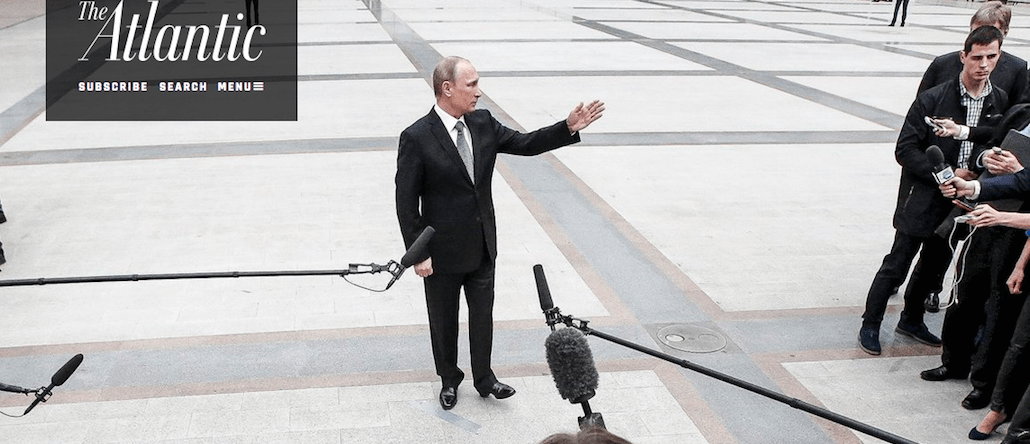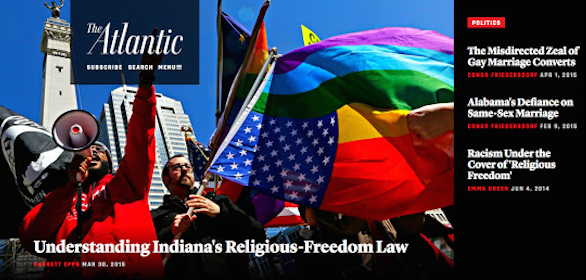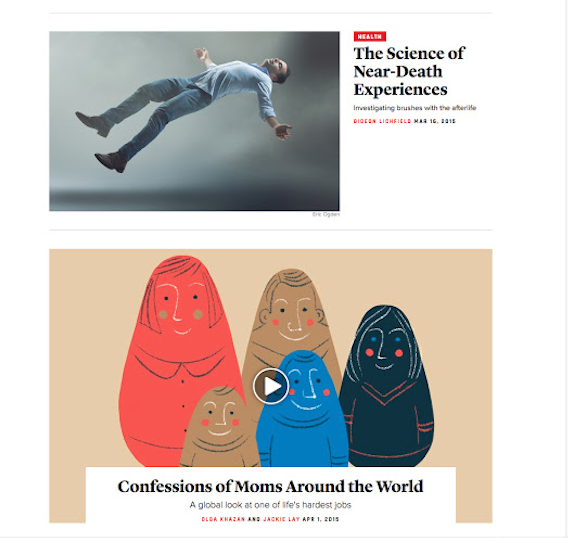
While most publishers are pushing recommended links and continuously scrolling article pages in front of users, The Atlantic is going in the opposite direction.
With its newly designed website, which went live Tuesday evening, the opinion and culture journal abandoned a series of tactics it once used to use to keep people clicking around the site.
The old site had, in addition to a “most popular” widget, modules containing video, more articles on the same subject, writers and their recent work, and, of course, the ubiquitous content-recommendation widget (powered by, in this case, Taboola) — all with the aim of goosing traffic. On the new site, those modules are gone except for the Most Popular and Taboola ones. Also gone is the navigation bar that TheAtlantic.com ran across the top of the site to point people to its menu of sections including politics, business and tech.
The Atlantic is small by today’s Web publishing standards, but it’s not exactly flailing; the site drew 12.7 million U.S. multiplatform uniques in March, up 52 percent from a year ago, according to comScore. With the new changes, the Atlantic is putting engagement first, recognizing as other publishers have that pageviews, while important, have their limits.
“We know that the main metric in our industry is unique visitors, and we fight hard to increase that stat every month, but we believe time on site is a way to measure the quality and loyalty of our audience, and we care about that, too,” said Bob Cohn, president and COO of The Atlantic. “And in the meantime, more engagement means more pages consumed — and more ads served.”

Kimberly Lau, vp and general manager of The Atlantic Digital, didn’t seem too worried that traffic would suffer as a result of the changes, pointing out that the modules and navigation bar weren’t driving much traffic anyway.
“There were like five different modules that people didn’t click on,” she said. As for the nav bar, she said, “It took up 200 to 300 pixels at the top of the page. What we found is, no one clicks on any of that stuff. We really took the opportunity to clear out a lot of the clutter.”
The Atlantic also continues to eschew the infinite scroll. While many sites have adopted the feature on their home or article pages, infinite, or endless scroll, others, including the just-relaunched WSJ.com, are holding out or rethinking their use of the tactic.
Lau said that while sites that use infinite scroll may get more pageviews per visit, the benefits tapered off as traffic growth was increasingly fueled by more ephemeral visits coming from Facebook and mobile. In The Atlantic’s case, just 5.5 percent of traffic is coming directly to the homepage, although that’s growing. Infinite scroll also presents publishers with the quandary of having to figure out what to serve the reader next.
“I think it’s easy when you’re a small site to have increased engagement,” Lau said. “As your site grows, it’s harder. You have more people coming from Facebook, from mobile, and that’s more one and done, as we like to call them.”
And some advertisers are pushing back on paying for impressions from infinite scrolling, which encourages quick scrolling, which in turn makes it difficult for ads to load in time.
Alan Smith, chief digital officer at Assembly, said that it’s highly unlikely that all ads will be viewable as the user scrolls down the page, which will lead brands to discount the pricing of these ads.
“UX experts would identify the top left of a page being the most consumed part of a site, but as that site grows longer and longer, it’s hard to predict audience consumption,” he said, “and so, in turn, harder to engage audience as much as possible to drive readership and interaction with content.”
To increase engagement, then, the new Atlantic site took cues from mobile devices, where people are spending more of their time. Stories that are deemed important will move down the page but still be presented in the same high-impact way, to keep people discovering them even after they leave in the top spot. A redesigned Most Popular module will include text below the headline of each story to encourage people to click.

And while it’s not using the endless scroll, The Atlantic has adopted a longer homepage format that mimics the scrolling behavior common to tablets and mobile phones. Other changes were designed to make the site look more uniform across devices, make native ads more prominent, and optimize for viewability as advertisers are demanding that their ads be seen by humans.
With the site redesign, The Atlantic also is introducing a new newsletter, The Atlantic Daily, which also was designed with engagement in mind. The Atlantic Daily replaces the Atlantic’s Top Stories newsletter, and while other publishers use newsletters to drive clicks back to their site, the Atlantic’s was designed to be read almost entirely in the recipient’s email, with just a few links out. To that end, the Atlantic will judge it by looking at open rates and subscriber growth more than click-through rates.
“This is finding new ways to have regular interaction with the audience and trying to convert casual readers into more hard-core fans,” Lau said.
Photos courtesy of The Atlantic.
More in Media

Digiday+ Research: Publishers’ growing focus on video doesn’t translate to social platforms
Major publishers have made recent investments in vertical video, but that shift is not carrying over to social media platforms.

Technology x humanity: A conversation with Dayforce’s Amy Capellanti-Wolf
Capellanti-Wolf shared insight on everything from navigating AI adoption and combating burnout to rethinking talent strategies.

How The Arena Group is rewriting its commercial playbook for the zero-click era
The company is testing AI-powered content recommendation models to keep readers moving through its network of sites and, in doing so, bump up revenue per session – its core performance metric.





